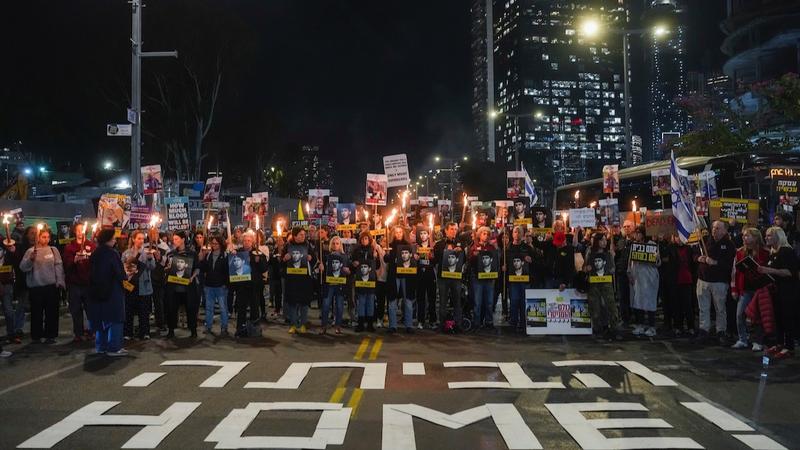Published 19:48 IST, January 14th 2025
Israel-Hamas Hostage Deal: 50 Palestinians In Swap Of Each Female Israeli Soldier Released
Israel-Hamas are at the closed point of reaching hostage swap deal ever since tensions between the two escalated following latter's Oct 7, 2023 attack.

Tel Aviv: A hostage swap deal between Israel and Hamas is almost final the latter accepted the draft agreement for a ceasefire in the Gaza strip. The deal is sealed will release of dozens of Israeli hostages after a long wait of several months, ever since October 7, 2023.
According to the inside details of the hostage deal brokered by the United States, Qatar and Egypt, Israel will release as many as 50 Palestinians for every single female Israeli soldier held hostage by Hamas and are still believed to be alive.
A draft agreement of the said hostage deal mentioning these details has been confirmed by Egyptian official and a Hamas official. An Israeli official also said that progress has been made, but the details are being finalized. The plan would need to be submitted to the Israeli Cabinet for final approval.
Hostage deal to be three phase agreement

The three-phase agreement — based on a framework laid out by US President Joe Biden and endorsed by the UN Security Council — would begin with the gradual release of 33 hostages over a six-week period, including women, children, older adults and wounded civilians in exchange for potentially hundreds of Palestinian women and children imprisoned by Israel.
Among the 33 would be five female Israeli soldiers, each of whom would be released in exchange for 50 Palestinian prisoners, including 30 convicted militants who are serving life sentences.
The Israeli official said Israel assumes most of the 33 are still alive.
During this first, 42-day phase, Israeli forces would withdraw from population centers, Palestinians would be allowed to start returning to their homes in northern Gaza and there would be a surge of humanitarian aid, with some 600 trucks entering each day.
Details of the second phase still must be negotiated during the first. Those details remain difficult to resolve — and the deal does not include written guarantees that the ceasefire will continue until a deal is reached. That leaves the potential for Israel to resume its military campaign after the first phase ends.
The Israeli official said “detailed negotiations” on the second phase will begin during the first. He said Israel will retain some “assets” throughout the negotiations, referring to a military presence, and would not leave the Gaza Strip until all the hostages are back home.
The three mediators have given Hamas verbal guarantees that negotiations will continue as planned and that they will press for a deal to implement the second and third phases before the end of the first, the Egyptian official said.
The deal would allow Israel throughout the first phase to remain in control of the Philadelphi corridor, the band of territory along Gaza’s border with Egypt, which Hamas had initially demanded Israel withdraw from. Israel would pull out from the Netzarim Corridor, a belt across central Gaza where it had sought a mechanism for searching Palestinians for arms when they return to the territory's north.
In the second phase, Hamas would release the remaining living captives, mainly male soldiers, in exchange for more prisoners and the “complete withdrawal” of Israeli forces from Gaza, according to the draft agreement.
Hamas has said it will not free the remaining hostages
Hostage deal in progress for over an year

The United States, Egypt and Qatar have spent the past year trying to mediate an end the 15-month war and secure the release of dozens of hostages captured in Hamas' October 7, 2023 attack that triggered it. Some 100 people are still captive inside Gaza, and the military believes at least a third them are dead.
Any deal is expected to deliver a pause in fighting and bring Israel and Hamas a step closer to winding down the most deadly and destructive war they’ve ever fought, a conflict that has destabilised the broader middle east and sparked worldwide protests.
It would bring relief to the hard-hit Gaza strip, where Israel's offensive large areas of territory into rubble and displaced around 90% of Gaza’s population of 2.3 million, many of whom are at risk of famine. Meanwhile, dozens of Israeli hostages would be reunited with their loved ones after months in captivity.
Officials have expressed optimism before, only for negotiations to grind to a halt. But they are now suggesting that they can conclude an agreement ahead of the Jan. 20 inauguration of US President-elect Donald Trump , whose Mideast envoy has joined the negotiations.
Qatari Foreign Ministry spokesman Majed al-Ansari said at a weekly briefing Tuesday that the ongoing negotiations were productive, while declining to get into the details.
“Today, we are at the closest point ever to having a deal,” he said.
Hamas, meanwhile, said in a statement that the ongoing negotiations had reached their “final stage."
What happened on October 7 attack?
In the October 7 attack, Hamas-led militants killed around 1,200 people, mostly civilians, and abducted another 250. Around half those hostages were freed during a brief ceasefire in November 2023.
Israel’s retaliatory offensive has killed over 46,000 Palestinians, more than half of them women and children, according to Gaza’s Health Ministry, which does not say how many of the dead were combatants.
Israeli strikes across Gaza overnight and into Tuesday killed at least 18 Palestinians, including two women and four children, according to local health officials, who said one of the women was pregnant and that the baby died as well.
There was no immediate comment from the Israeli military. Israel says it only targets militants and accuses them of hiding among civilians.
With inputs from AP
Updated 22:54 IST, January 14th 2025




